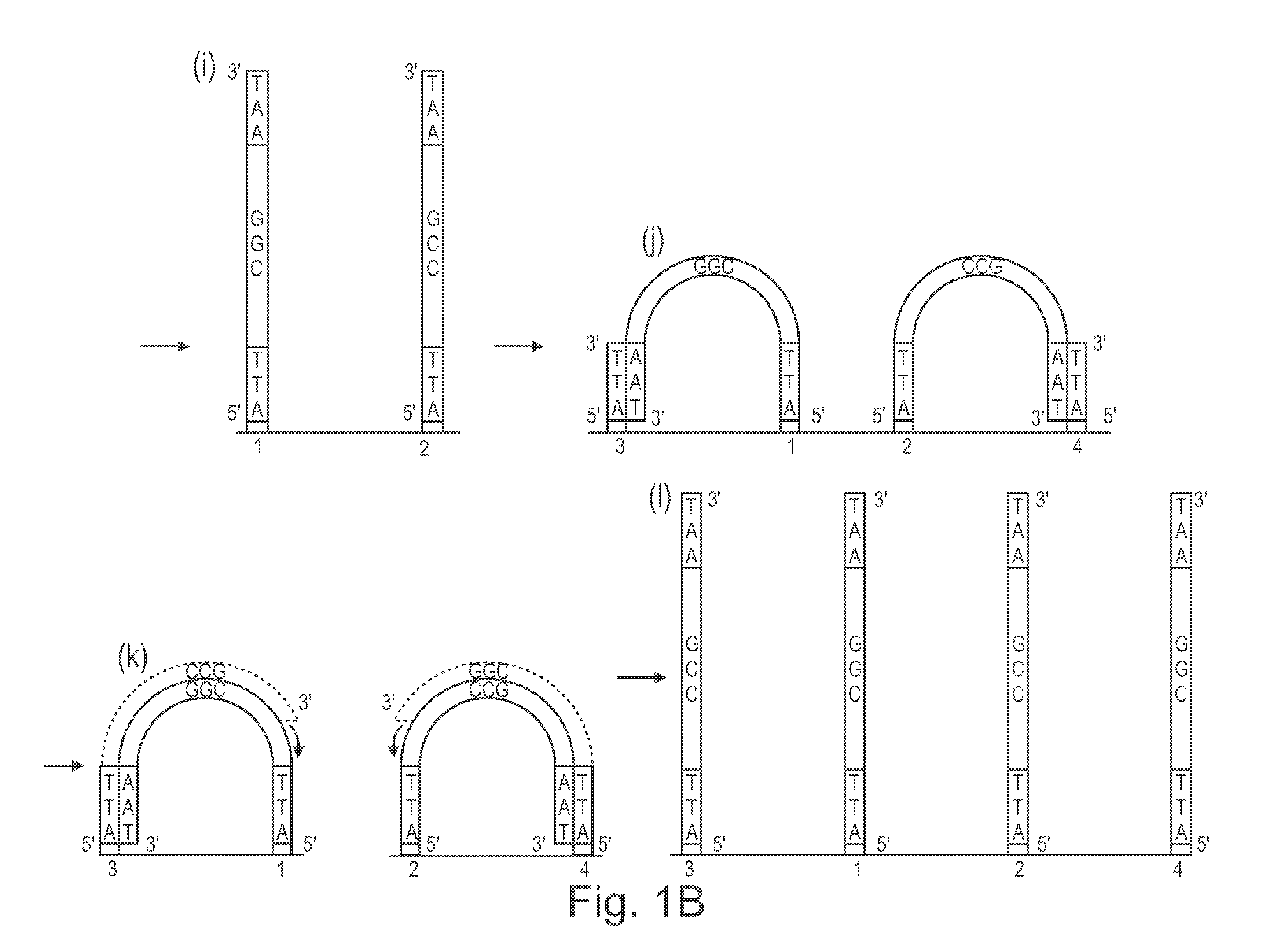Method of nucleic acid amplification
a nucleic acid and amplification technology, applied in the field of amplification of nucleic acids, can solve the problems of insufficient non-radioactive detection, inability to decrease indefinitely the time required to process a single sample, and limited amount of transferred dna ,
- Summary
- Abstract
- Description
- Claims
- Application Information
AI Technical Summary
Benefits of technology
Problems solved by technology
Method used
Image
Examples
example 1
[0145]Oligonucleotides, phosphorylated at their 5′-termini (Microsynth GmbH, Switzerland), were grafted onto Nucleolink plastic microtitre wells (Nunc, Roskilde, Denmark). The sequence of the oligonucleotide p57 corresponds to the sequence 5′-TTTTTTCACCAACCCAAACCAACCCAAACC (SEQ ID NO:1) and p58 corresponds to the sequence 5′-TTTTTTAGAAGGAGAAGGAAAGGGAAAGGG (SEQ ID NO:2). Microtitre wells with p57 or p58 were prepared as follows. In each Nucleolink well, 30 μl of a 160 nM solution of the oligonucleotide in 10 mM 1-methyl-imidazole (pH 7.0) (Sigma Chemicals, St. Louis, Mo.) was added. To each well, 10 μl of 40 mM 1-ethyl-3-(3-dimethylaminopropyl)-carbodiimide (pH 7.0) (Sigma Chemicals) in 10 mM 1-methyl-imidazole, was added to the solution of oligonucleotides. The wells were then sealed and incubated at 50° C. overnight. After the incubation, wells were rinsed twice with 200 μl of RS (0.4N NaOH, 0.25% Tween 20 (Fluka Chemicals, Switzerland)), incubated 15 minutes with 200 μl RS, washed...
example 2
[0154]A mix of two oligonucleotides which are phosphorylated at the 5′-end (Microsynth GmbH, Balgach, Switzerland) have been grafted on 96 well Nucleolink plates (Nunc, Denmark) as recommended by the manufacturer. The resulting plates has been stored dry at 4° C. The sequence of the primer, P1, was 5′-GCGCGTAATACGACTCACTA (SEQ ID NO:5), the sequence of the other primer, P2, was 5′-CGCAATTAACCCTCACTAAA (SEQ ID NO 6). These plates are specially formulated by Nunc, allowing the covalent grafting of 5′ phosphorylated DNA fragments through a standard procedure.
[0155]A template has been cloned in a vector (pBlueScript Skminus, Stratagene Inc, San Diego, Calif.) with the appropriate DNA sequence at the cloning site (i.e., corresponding to PI and P2 at position 621 and 794 respectively), and 174 bp long linear double stranded DNA template has been obtained by PCR amplification, using P1 and P2. The template PCR product has been purified on Qiagen Qia-quick columns (Qiagen GmbH, Hilden, Germ...
example 3
[0159]Oligonucleotides (Microsynth GmbH, Switzerland) were grafted onto Nucleolink wells (Nunc, Denmark). Oligonucleotide PI corresponds to the sequence 5′-TTTTTTCTCACTATAGGGCGAATTGG (SEQ ID NO:7) and oligonucleotide P2 corresponds to 5′-TTTTTTCTCACTAAAGGGAACAAAAGCTGG (SEQ ID NO:8). In each Nucleolink well, a 45 μl of 10 mM 1-methyl-imidazole (pH 7.0) (Sigma Chemicals, St. Louis, Mo.) solution containing 360 fmol of PI and 360 fmol of P2 was added. To each well, 15 μl of 40 mM 1-ethyl-3-(3-dimethylaminopropyl)-carbodiimide (pH 7.0) (Sigma Chemicals) in 10 mM 1-methyl-imidazole, was added to the solution of oligonucleotides. The wells were then sealed and incubated at 50° C. for 16 hours. After the incubation, wells have been rinsed twice with 200 μl of RS (0.4N NaOH, 0.25% Tween 20), incubated 15 minutes with 200 μl RS, washed twice with 200 μl RS, and twice with 200 μl TNT (100 mM Tris / HCl pH7.5, 150 mM NaCl, 0.1% Tween 20), before they are put to dry at 50° C. in an oven. The drie...
PUM
| Property | Measurement | Unit |
|---|---|---|
| Length | aaaaa | aaaaa |
| Size | aaaaa | aaaaa |
Abstract
Description
Claims
Application Information
 Login to View More
Login to View More - R&D
- Intellectual Property
- Life Sciences
- Materials
- Tech Scout
- Unparalleled Data Quality
- Higher Quality Content
- 60% Fewer Hallucinations
Browse by: Latest US Patents, China's latest patents, Technical Efficacy Thesaurus, Application Domain, Technology Topic, Popular Technical Reports.
© 2025 PatSnap. All rights reserved.Legal|Privacy policy|Modern Slavery Act Transparency Statement|Sitemap|About US| Contact US: help@patsnap.com



